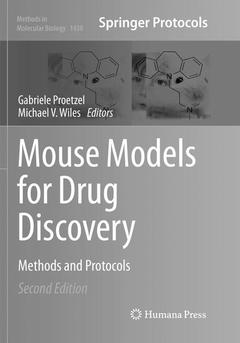Description
Mouse Models for Drug Discovery (2nd Ed., 2nd ed. 2016)
Methods and Protocols
Methods in Molecular Biology Series, Vol. 1438
Coordinators: Proetzel Gabriele, Wiles Michael V.
Language: English
Subject for Mouse Models for Drug Discovery:
Support: Print on demand
Publication date: 05-2016
436 p. · 17.8x25.4 cm · Hardback
Description
/li>Contents
/li>Comment
/li>
1. Genetically Defined Strains in Drug Development and Toxicity Testing
Michael F.W. Festing
2. Simple, Efficient CRISPR-Cas9 Mediated Gene Editing in Mice: Strategies and Methods
Benjamin E. Low, Peter M. Kutny, and Michael V. Wiles
3. Mouse Sperm Cryopreservation and Recovery of Genetically Modified Mice
Benjamin E. Low, Rob A. Taft, and Michael V. Wiles
4. Generation of Immunodeficient Mice Bearing Human Immune Systems by the Engraftment of Hematopoietic Stem Cells
Suheyla Hasgur, Ken Edwin Aryee, Leonard D. Shultz, Dale L. Greiner, and Michael A. Brehm
5. Generation of Human Liver Chimeric Mice for the Study of Human Hepatotropic Pathogens
Markus von Schaewen, Gabriela Hrebikova, and Alexander Ploss
6. Human FcRn Transgenic Mice for Pharmacokinetic Evaluation of Therapeutic Antibodies
Derry C. Roopenian, Gregory J. Christianson, Gabriele Proetzel, and Thomas J. Sproule
7. A Humanized Mouse Model to Study Human Albumin and Albumin Conjugates Pharmacokinetics
Benjamin E. Low and Michael V. Wiles
8. Germ-Free Mice Model for Studying Host-Microbial Interactions
Yogesh Bhattarai and Purna Kashyap
9. Bridging Mice to Men: Using HLA Transgenic Mice to Enhance the Future Prediction and Prevention of Autoimmune Type 1 Diabetes in Humans
David V. Serreze, Marijke Niens, John Kulik, and Teresa P. DiLorenzo
10. Mouse Models of Type 2 Diabetes Mellitus in Drug Discovery
Helene Baribault
11. Cholesterol Absorption and Metabolism
Philip N. Howles
12. Skin Diseases in Laboratory Mice: Approaches to Drug Target Identification and Efficacy Screening
John P. Sundberg, Kathleen A. Silva, Lloyd E. King, Jr, and C. Herbert Pratt
13. Chronic Myeloid Leukemia (CML) Mouse Model in Translational Research
Cong Peng and Shaoguang Li
14. Murine Model for Colitis-Associated Cancer of the Colon
Ashley J. Snider, Agnieszka B. Bialkowska, Amr M. Ghaleb, Vincent W. Yang, Lina M. Obeid, and Yusuf A. Hannun
15. Mouse Models for Studying Depression-Like States and Antidepressant Drugs
Carisa L. Bergner, Amanda N. Smolinsky, Peter C. Hart, Brett D. Dufour, Rupert J. Egan, Justin L. LaPorte, and Allan V. Kalueff
16. Experimental Models of Anxiety for Drug Discovery and Brain Research
Peter C. Hart, Carisa L. Bergner, Amanda N. Smolinsky, Brett D. Dufour, Rupert J. Egan, Justin L. LaPorte, and Allan V. Kalueff
<17. Repetitive Behavioral Assessments for Compound Screening in Mouse Models of Autism Spectrum Disorders
Stacey J. Sukoff Rizzo
18. Better Utilization of Mouse Models of Neurodegenerative Diseases in Preclinical Studies: From the Bench to the Clinic
Christopher Janus, Carolina Hernandez, Victoria deLelys, Hanno Roder, and Hans Welzl
19. Neuromuscular Disease Models and Analysis
Robert W. Burgess, Gregory A. Cox, and Kevin L. Seburn
20. Brightfield Imaging and Optical Coherence Tomography of the Mouse Posterior Eye
Mark P. Krebs, Mei Xiao, Keith Sheppard, Wanda Hicks, and Patsy M. Nishina
21. Mouse Models as Tools to Identify Genetic Pathways for Retinal Degeneration, as Exemplified by Leber's Congenital Amaurosis
Bo Chang
Incudes fully updated cutting-edge methods and protocols for using mouse models in drug research
Provides step-by-step detail essential for reproducible results
Contains key notes and implementation advice from the experts
Includes supplementary material: sn.pub/extras



